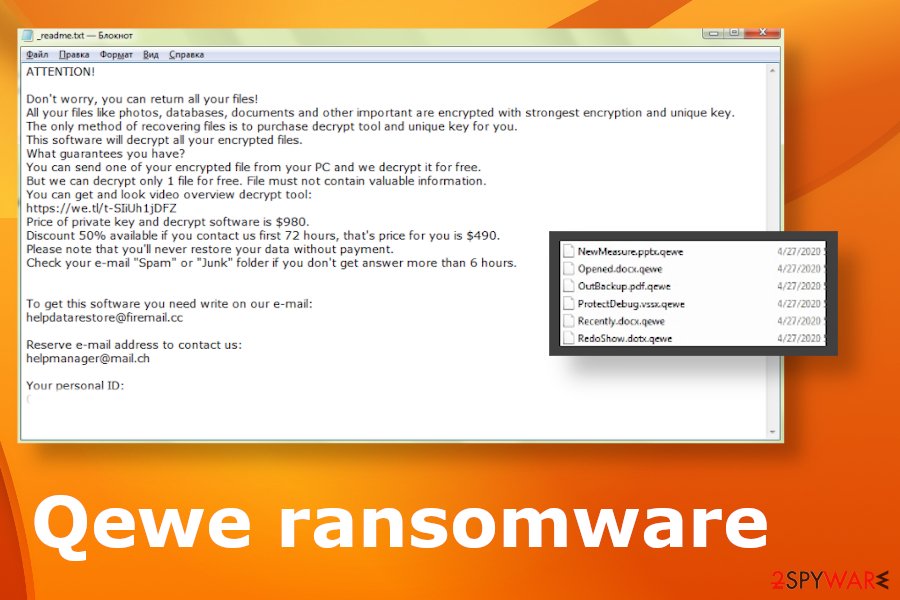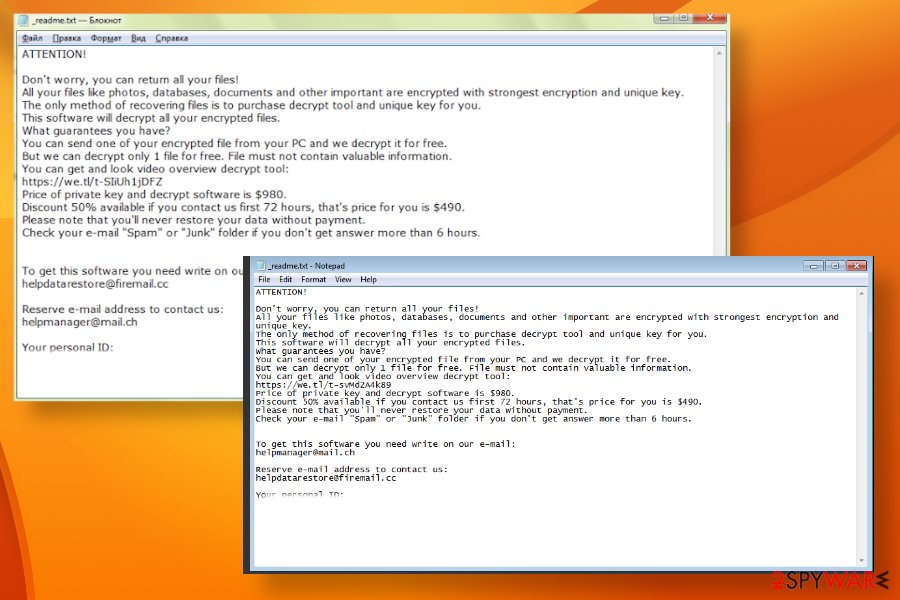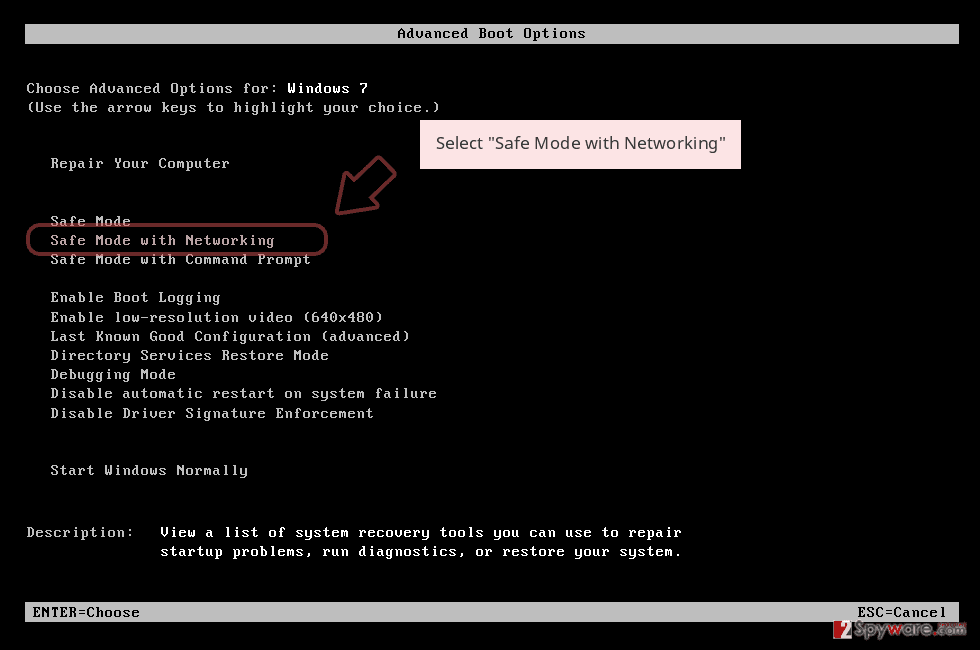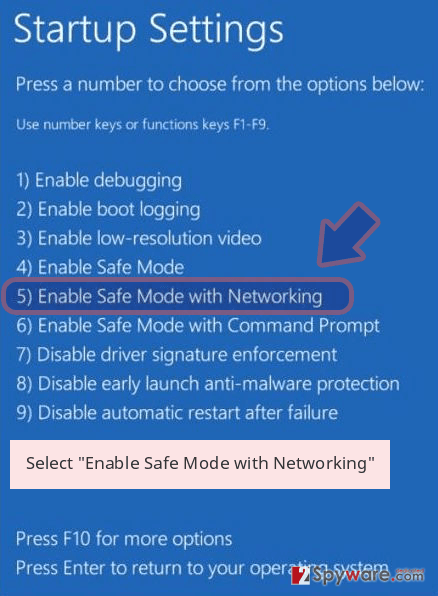Qewe ransomware is the ransomware that cannot get decrypted unless the offline keys get used in the encryption process


Qewe ransomware is one of many Djvu family versions that count more than 220 separate variants already. This is the threat that runs in the background and causes all the changes before it displays any visible symptoms. The first and the most important function that this malware has is file locking that allows the creators of the virus to make a profit directly from victims. Users notice data that gets marked using .qewe extension nad becomes inoperable. This is the indication of a successful encryption procedure that ransomware runs as soon as it lands on the computer. Since Djvu ransomware and STOP virus family, in general, are known creators of dangerous cryptocurrency-extortion based threats, we can immediately tell that paying is not an option, in this case.
Even though versions that came out before August of 2019 were easily decryptable, Qewe ransomware virus is no longer based on the same coding and encryption functions. Online keys were used less often, so many people got their files restored with the help of researchers and tools designed to find victims of the same version. Ransomware now connects to the server each time the encryption process runs on the targeted machine, so victims get unique victim IDs that are no longer matching with any other person or users. Emsisoft still offers the procedure of recovering files, but their Djvu decryption is based on offline IDs only, so when your ID in the ransom note file ends in t1, you can have the option of decryption. However, other victims cannot repair the damage since keys are formed separately for each of them.[1]
Qewe ransomware is the version in a family that is active and not stopping, so new versions come out more often since the coding is not much altered for each of them. This also indicates a few distinct features of the Djvu malware that are not changed for a while now. The ransom note is delivering the same text, ransom offer, and is named _readme.txt fir at least two years. Also, [email protected], [email protected] contact emails are the same for may recent versions like .jope or .lalo.
| Name | Qewe ransomware |
|---|---|
| Family | This threat belongs to a well-known Djvu ransomware family that became extremely active in the second half of 2019 and remained extremely dangerous in 2020 |
| File marker | .qewe – the file extension that occurs on every file affected by the threat. It comes after the original name and the file type indicator, so shows the affected files in alongside other ones that are not encoded |
| Ransom note | _readme.txt is the known name of a text file that contains a ransom-demanding message from creators of the dangerous virus. This note contains details about encryption and contact information, the ransom amount |
| Ransom amount | The amount these criminals want from victims is $980, but actors also offer the discount of 50% for users who contact extortionists in the first 72 hours |
| Distribution | In most reports, this threat is delivered via pirated software packages and malicious or even hacked websites. In general, one f the more common ways to spread such malware are infected files that get attached to emails in spam campaigns[2] |
| Damage | Ransomware is based on blackmail, so your money goes directly to criminals. This communication and money transferring can lead to issues with privacy and money loss. You need to take into the consideration that ransomware can easily spread other threats around without many efforts |
| Elimination | Qewe ransomware removal can be quicker and give more satisfying results if you run the professional anti-malware tool to find all the dangerous files automatically. AV engines can clear malware thoroughly |
| System fix | Run Reimage Reimage Cleaner Intego or a similar system optimization tool or even a PC repair application to identify affected or even damaged parts of the computer and system folders and files |
Qewe ransomware is the version of the virus that was decryptable before. Cybercriminals evolve and make their products more persistent, so these malware creators updated their coding procedures and started to use more advanced methods and rely on online IDs. Offline keys can change with versions only, these keys were more useful for researchers and malware-fighting tools. Online IDs allow making each victim unique and different from other users affected by the same version of the ransomware.
There is no solution for your files expert recovery from backups because these victim IDs needed for decryption tools are stored on malicious actors’ servers. Unless the database of the malware creators get leaked or Qewe ransomware developers get caught by law enforcement.
Qewe ransomware removal is not helping to unlock your files, so you need to delete the infection for the sake of the security and to clear the malware traces to avoid further damage. However, files email locked and useless. Anti-malware tools can detect and indicate threats that behave suspiciously or maliciously. Once you get the list of malware, you need to clear them all off of the system and repair damage after that.
The most important thing is to remove Qewe ransomware before start anything else, especially data recovery because your files may get encrypted again and damaged permanently. Ransomware scripts can run in the background and affect security features, other programs and run the encryption again if you do not remove all parts of the infection.
Anti-malware tools are based on detecting malicious behavior, so various programs related to Qewe ransomware can get indicated at the same time as the main payload file. However, often the processes that are set to run in the background cannot be easily stopped or found. You may need to rely on a few AV tools to double-check or enter the Safe More before you run the anti-malware in the first place. 
Qewe ransomware is the virus that marks data using its own file extension as an indicator for affected files.

Qewe ransomware is the virus that marks data using its own file extension as an indicator for affected files.
In most cases, when Qewe ransomware virus is dropped on the system all the processes start in stages. before the encryption is triggered this malware shows a fake window stating about Windows Update or different procedures, so slowness or different interruptions that users notice could be not they suspicious. However, even these masking techniques are useless when the ransom note appears.
Qewe ransomware delivers _readme.txt file on the desktop, places this note in many folders with encrypted files, and expects victims to follow the wanted steps:
ATTENTION!
Don’t worry, you can return all your files!
All your files like photos, databases, documents and other important are encrypted with strongest encryption and unique key.
The only method of recovering files is to purchase decrypt tool and unique key for you.
This software will decrypt all your encrypted files.
What guarantees you have?
You can send one of your encrypted file from your PC and we decrypt it for free.
But we can decrypt only 1 file for free. File must not contain valuable information.
You can get and look video overview decrypt tool:
hxxps://we.tl/t-svMd2A4k89
Price of private key and decrypt software is $980.
Discount 50% available if you contact us first 72 hours, that’s price for you is $490.
Please note that you’ll never restore your data without payment.
Check your e-mail “Spam” or “Junk” folder if you don’t get answer more than 6 hours.To get this software you need write on our e-mail:
[email protected]Reserve e-mail address to contact us:
[email protected]Your personal ID:
Paying ransomware is never an option because direct contact between victims and criminals can lead to more issues besides the initial file encryption. When you transfer the amount, Qewe ransomware asked, you may be asked to pay more and more or receive an email with another malware script.
Qewe ransomware often is the secondary payload of a trojan or worm attack. So rely on professional anti-malware tools and can the system fully. The in-depth check can clean the system and improve the performance without causing additional damage. However, manual changes in system settings and program work can.
Running the PC repair tool after proper system cleaning should help with Qewe ransomware virus damage. Tools like Reimage Reimage Cleaner Intego can find, indicate, and fix the damage that ransomware triggered with background processes and all the deletion or installation of apps and data. For data recovery options, file backups need to be updated more often, so you do not need to search for other solutions when ransomware occurs. 
Qewe ransomware – threat that demands money with the discount offer, so people are more eager to pay up.

Qewe ransomware – threat that demands money with the discount offer, so people are more eager to pay up.
Malicious files get placed on targeted devices
Malware evolves as technologies change. Cybercriminals also rely on more modern ways to spread their products around. This is the reason why ransomware is more stealthily and dangerous than ever before. malicious actors were more focused on email campaigns before and obtained payments from people who opened a malicious attachment from emails.
Now there are more hacked or malicious sites with triggers that allow downloads of malicious scripts and start infections like this. In addition, pirated sites, and torrent services become one more technique that allows spreading malware payload via files attached to software packages. In most cases, online games, cheats, software cracks, and license numbers when downloaded triggers the infection.
The best solution for avoidance of these infections can be paying attention to sources and choosing the official sites, not torrent or other sharing services. Illegal downloads and licensed versions are never a good idea. Keep anti-malware tools running more often, so these infections get indicated at the start of an infiltration.
Qewe ransomware termination procedures go before file recovery
You need to note how important Qewe ransomware removal process is and take care of your machine as soon as possible, so nothing that this file-locker does could damage your machine permanently. Data that is encrypted can be lost if you have no backups and other options do not work, but the sooner you clean malware off of the device the better.
Getting the professional anti-malware tool can help to remove Qewe ransomware more thoroughly and quickly. Anti-malware tools and security programs like SpyHunter 5Combo Cleaner or Malwarebytes can clear malicious programs and files triggering unwanted functions. This way you can base your selection on detection[3] and run the tool that is capable of clearing all malware.
Of course, there is an issue that Qewe ransomware virus creates besides the direct file encryption – damage. System files and functions often gel disabled, so malware runs with each reboot, and the virus can spread around easily. These alterations shouldn’t be fixed manually, so rely on Reimage Reimage Cleaner Intego or get system optimization programs for performance improvements.
Remove Qewe using Safe Mode with Networking
Rely on system reboot in Safe Mode with Networking because this option allows you to run the AV tool freely and find Qewe ransomware traces for the best removal
- Windows 7 / Vista / XP
- Click Start → Shutdown → Restart → OK.
- When your computer becomes active, start pressing F8 multiple times until you see the Advanced Boot Options window.
- Select Safe Mode with Networking from the list

Windows 10 / Windows 8
- Press the Power button at the Windows login screen. Now press and hold Shift, which is on your keyboard, and click Restart..
- Now select Troubleshoot → Advanced options → Startup Settings and finally press Restart.
- Once your computer becomes active, select Enable Safe Mode with Networking in Startup Settings window.

-
Log in to your infected account and start the browser. Download Reimage Reimage Cleaner Intego or other legitimate anti-spyware program. Update it before a full system scan and remove malicious files that belong to your ransomware and complete Qewe removal.
If your ransomware is blocking Safe Mode with Networking, try further method.
Remove Qewe using System Restore
System Restore should help with clearing the system from viruses because your device will get recovered to a previous state when the threat was not active
Bonus: Recover your data
Guide which is presented above is supposed to help you remove Qewe from your computer. To recover your encrypted files, we recommend using a detailed guide prepared by 2-spyware.com security experts.
If your files are encrypted by Qewe, you can use several methods to restore them:
Data Recovery Pro is the program that can provide another option when you don’t have the right data backups
You can use this program for encrypted files or any data that gets deleted by accident
- Download Data Recovery Pro;
- Follow the steps of Data Recovery Setup and install the program on your computer;
- Launch it and scan your computer for files encrypted by Qewe ransomware;
- Restore them.
Windows Previous Versions can provide a solution for file recovery after the Qewe ransomware attack
When System Restore gets enabled, you can rely on Windows Previous versions and recover files affected during the ransomware attack
- Find an encrypted file you need to restore and right-click on it;
- Select “Properties” and go to “Previous versions” tab;
- Here, check each of available copies of the file in “Folder versions”. You should select the version you want to recover and click “Restore”.
ShadowExplorer is the feature of Windows PCs
If you are sure that Qewe ransomware left Shadow Volume Copies untouched, you can rely on ShadowExplorer and restore encrypted files
- Download Shadow Explorer (http://shadowexplorer.com/);
- Follow a Shadow Explorer Setup Wizard and install this application on your computer;
- Launch the program and go through the drop down menu on the top left corner to select the disk of your encrypted data. Check what folders are there;
- Right-click on the folder you want to restore and select “Export”. You can also select where you want it to be stored.
Try the Djvu decryption tool
Qewe ransomware is the version that is advanced and less likely to get decrypted, but Emsisoft decryption tool for Djvu can possibly help for some of the versions
Finally, you should always think about the protection of crypto-ransomwares. In order to protect your computer from Qewe and other ransomwares, use a reputable anti-spyware, such as Reimage Reimage Cleaner Intego, SpyHunter 5Combo Cleaner or Malwarebytes
This entry was posted on 2020-04-27 at 06:59 and is filed under Ransomware, Viruses.

